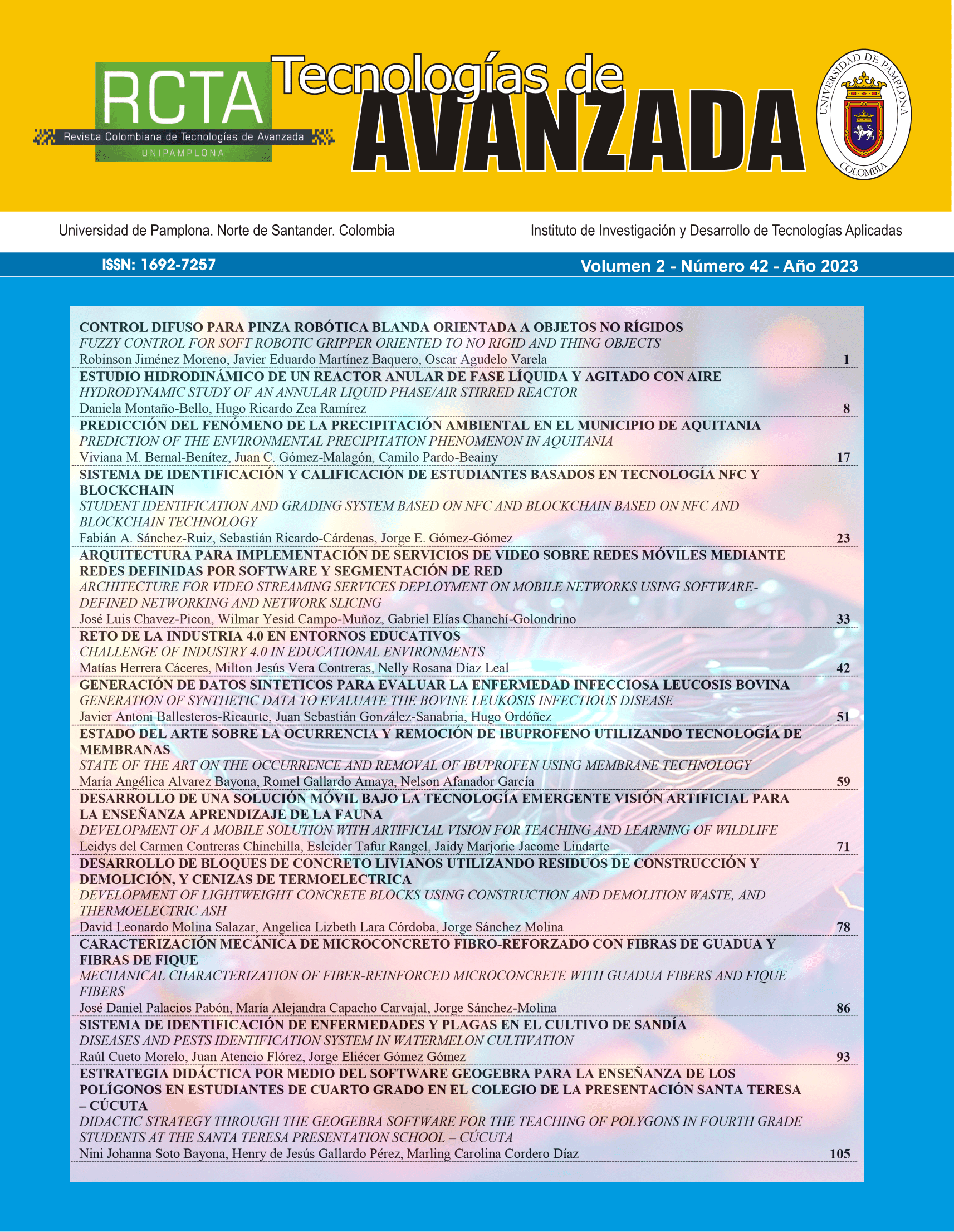DIDACTIC STRATEGY THROUGH THE GEOGEBRA SOFTWARE FOR THE TEACHING OF POLYGONS IN FOURTH GRADE STUDENTS AT THE SANTA TERESA PRESENTATION SCHOOL – CÚCUTA
DIDACTIC STRATEGY THROUGH THE GEOGEBRA SOFTWARE FOR THE TEACHING OF POLYGONS IN FOURTH GRADE STUDENTS AT THE SANTA TERESA PRESENTATION SCHOOL – CÚCUTA
DOI:
https://doi.org/10.24054/rcta.v2i42.2687Keywords:
Teaching, Learning, Polygons, Geometry, Software, Geometric ThinkingAbstract
Education is in constant search of educational quality, for this reason different ways have been investigated to change the traditional education, by making use of new teaching strategies in which the use of technological tools is included. Nowadays, for the teaching of the area of mathematics, it is about leaving the conventional; for this reason, teachers have seen the need to use educational software, among which is the Geogebra software for the teaching of various topics, which must be addressed according to the grade in which students are. The main purpose of this project is to create a didactic strategy using Geogebra software for teaching polygons to fourth grade students. To carry it out, it was necessary to make use of a mixed research approach because in this way it was possible to collect all the necessary information to fulfill the objectives and thus provide a solution to the problem addressed in the study. Likewise, a recurrent triangulation was taken into account that allowed linking qualitative and quantitative methods to fulfill the established objectives. The research was carried out with the participation of 31 students to whom a test with open questions was applied to perform the diagnostic test, which allowed identifying the strengths and weaknesses of the students with respect to the subject of polygons. In addition, participant observation was carried out in order to carry out the different activities for the teaching of polygons and a semi-structured interview. The results showed that there is, in the first instance, apathy for the subject, which is reflected in the academic results of the students. When analyzing the results of the pre-test it can be said that there are deficiencies in terms of the subject matter because a large majority of students did not obtain favorable results and show deficiencies in the identification of the properties of polygons, but these deficiencies were improved after carrying out didactic activities using Geogebra software, as evidenced by the results of the post-test, which significantly surpassed those of the pre-test, and the students developed skills for the identification of polygons and their properties, stating that the activities developed with the software were fun and applicable to the context in which they find themselves.
Downloads
References
Alvarado, L. y Gracía, M. (2008). “Características más relevantes del paradigma socio-crítico. Sapiens”. Revista de investigación, Vol. 9, No. 2, pp. 187-202
Álvarez-Gayou L. (2006). Cómo hacer investigación cualitativa. Paidós, México.
Arteaga, E., Medina, J. y Martínez, J. (2019). “El Geogebra: una herramienta tecnológica para aprender Matemática en la Secundaria Básica haciendo matemática”. Revista Conrado. Vol. 15, No. 70, pp. 102-108.
Benlliure, V. (2019). Teoría y práctica de la creatividad, Valencia: Universidad de Valencia.
Camargo, C y Acosta, M. (2012). La geometría, su enseñanza y su aprendizaje, Valencia: Universidad de Valencia.
Canizales, J. (2004). “Estrategias didácticas para activar el desarrollo de los procesos de pensamiento en el preescolar”. Investigación y Postgrado. Vol. 19, No. 2, 179-200.
Cardeño, J. y Córdoba, F. (2013). Innovación en la enseñanza de las matemáticas. Bogotá: Fondo Editorial ITM
Elliott, J. (200). La investigación-acción en educación. Buenos Aires: Ediciones Morata
Gallardo H, Vergel M, Villamizar F. (2017). “Investigación intervención y enfoque multimétodo en ciencias humanas y educación matemática”. Logos, Ciencia y Tecnología. Vol. 9, No. 2, pp. 85-96
Habermas, J. (1988). La lógica de las ciencias sociales. Madrid: Editorial Tecnos
Hernández, R. y Mendoza, C. (2018). Metodología de la investigación: las rutas cuantitativa, cualitativa y mixta. México: McGraw Hill.
Herrera, J. y Ochoa, E. (2022). “Análisis de la relación entre educación y tecnología”. Cultura, Educación y Sociedad. Vol. 13, No. 2, pp. 47-68.
Lazo, M. (2009). “David Asubel y su aporte a la Educación”. Revista Ciencia UNEMI, Vol. 2, No. 3, pp. 20-23
López, O. y García, S. (2008). La Enseñanza de la Geometría. México: Instituto Nacional para la Evaluación de la Educación.
Morales, A y Damián, A. (2021). “Estrategia didáctica fundamentada en el uso de GeoGebra para mejorar la comprensión del concepto de semejanza de triángulos”. Innovación educativa, Vol. 21, No. 87, pp. 11-33
Núñez, J. (2017). “Los métodos mixtos en la investigación en educación: hacia un uso reflexivo”. Cuadernos de Pesquisa, Vol. 47, No. 164, pp. 632-649.
OECD. (2018). Results from PISA 2018. Colombia - Country Note - PISA 2018 Results.
Ospina, C. (2017). Las Tic como herramienta de motivación en el aula. Bogotá: Universidad de la Sabana
Pereira, Z. (2011). “Los diseños de método mixto en la investigación en educación: Una experiencia concreta”. Revista Electrónica Educare, Vol 15, No. 1, pp. 15-29
Sánchez, R. y Borja, A. (2022). “Geogebra en el proceso de Enseñanza-Aprendizaje de las Matemáticas”. Dominio de las Ciencias. Vol. 8, No. 2, pp. 33-52
Viera, T. (2003). “El aprendizaje verbal significativo de Ausubel. Algunas consideraciones desde el enfoque histórico cultural”. Universidades. No. 26, pp. 37-43.
Published
Versions
How to Cite
Issue
Section
License
Copyright (c) 2023 REVISTA COLOMBIANA DE TECNOLOGÍAS DE AVANZADA

This work is licensed under a Creative Commons Attribution-NonCommercial 4.0 International License.














